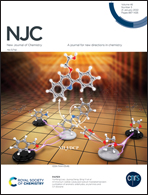Selective hydrogenation of butyl levulinate to γ-valerolactone over sulfonated activated carbon-supported SnRuB bifunctional catalysts†
Abstract
The synthesis of γ-valerolactone (GVL) from butyl levulinate (BL) hydrogenation over sulfonated activated carbon (SAC) supported SnRuB bifunctional catalysts was studied. These catalysts were characterized by ICP, nitrogen physisorption, XRD, HRTEM, XPS and NH3-TPD techniques. The SnRuB hydrogenation active site and surface acidic site of the SAC support are effectively retained by the co-impregnation followed by a chemical reduction process and display a prominent synergetic effect for BL hydrogenation to GVL. Under the optimal reaction conditions (180 °C, 3 MPa, 800 rpm, 3 h), BL conversion of 99.2% and GVL selectivity of 83.8% were obtained over the optimal 20Sn1RuB/SAC catalyst. The highest total fraction of the C![[double bond, length as m-dash]](https://www.rsc.org/images/entities/char_e001.gif) O group, lattice oxygen (Oα) and oxygen vacancies (Oβ) and active SnOx species on the surface of the catalyst contribute to the best adsorption and hydrogenation ability for BL conversion to GVL over the 20Sn1RuB/SAC catalyst. The sulfonated carbon-supported SnRuB bifunctional catalyst also showed outstanding recyclability in six runs due to enhanced reduction degree of Snn+ species, and strong interaction between the SnRuB active site and SAC support. In sum, the sulfonated carbon-supported SnRuB bifunctional catalyst with low costs, high activity and good recyclability is a potential candidate for butyl levulinate hydrogenation to GVL.
O group, lattice oxygen (Oα) and oxygen vacancies (Oβ) and active SnOx species on the surface of the catalyst contribute to the best adsorption and hydrogenation ability for BL conversion to GVL over the 20Sn1RuB/SAC catalyst. The sulfonated carbon-supported SnRuB bifunctional catalyst also showed outstanding recyclability in six runs due to enhanced reduction degree of Snn+ species, and strong interaction between the SnRuB active site and SAC support. In sum, the sulfonated carbon-supported SnRuB bifunctional catalyst with low costs, high activity and good recyclability is a potential candidate for butyl levulinate hydrogenation to GVL.



 Please wait while we load your content...
Please wait while we load your content...